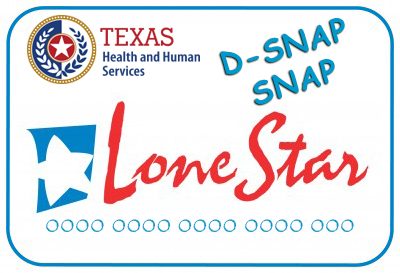When a natural disaster occurs, state, county and city leaders must assess the damage and also do a head count of residents that may have lost food, water and shelter. Operations, plans and projects are put into place and state agencies begin requesting waivers and assistance at the federal level. For Texans, that natural disaster is Hurricane Harvey.
The Texas Health and Human Services Commission (HHSC) has overseen the Disaster Supplemental Nutrition Assistance Program (D-SNAP) and the Supplemental Nutrition Assistance Program (SNAP). As of Oct. 11, HHSC has provided more than $467 million in benefits and processed more than 440,000 applications from households for D-SNAP assistance, according to HHSC Chief Press Officer Carrie Williams. “We had more than 1,000 employees volunteer to travel to the affected areas and help stand up D-SNAP sites,” said Williams. “The feedback we’ve received is overwhelmingly positive. Our staff have big hearts and were happy to help families face-to-face. It’s incredibly rewarding for them, many of them victims of the storm themselves. The work we do is incredibly worthwhile, and we had staff members working round the clock to get benefits out the door.”

HHSC was also granted approval to assist SNAP recipients impacted in one of the counties included in the State Disaster Declaration to have their Lone Star Card automatically loaded and replaced if it was lost during the disaster. Texas issued $160 million in benefits early to more than 600,000 SNAP households. Texas issued replacement benefits to more than 716,000 SNAP households in the affected counties. SNAP, formerly the food stamp program, offers nutrition assistance to millions of eligible, low-income individuals and families that meet the eligibility (Texas site, USDA site) requirements. FNS also approved a state hot foods waiver to allow households to purchase hot foods and hot food products prepared for immediate consumption.
HHSC announced they would begin offering disaster food relief, D-SNAP, on Sept. 13, to residents of counties within the federal disaster declaration. Recipients were given a Lone Star Card that was loaded within three days with funds to purchase food from most grocery stores. Texas HHSC began offering the benefits in stages, starting with an 11-county area that had smaller populations that could be served through the health and human services offices in those counties. Larger-population sites, such as in Houston and Corpus Christi, quickly followed with special sites to accommodate large volumes of people who would not be able to be efficiently served through a local HHSC office.
- To be eligible for D-SNAP, the recipient must be from a county that has been declared a federal disaster area.
- Have experienced a loss of income, destruction of home or a disaster-related expense, such as temporary shelter or home repairs.
- Not have been getting regular SNAP food benefits at the time of the disaster.
- Meet certain income limits. Click here to view income limits.
The application period has closed for residents in several counties since the initial announcement of D-SNAP relief. Residents in Galveston and Wharton counties are eligible for D-SNAP through Oct. 15 and residents of Montgomery County will be eligible Oct. 16-20. If a resident has been displaced and can’t get to their county during the active window for D-SNAP, they can go to any local HHSC benefits office across Texas to apply for D-SNAP during the days that program is active in their home county. The recipient must show proof of identity such as a driver’s license or other government-issued identification.
Quick background on food security assistance:
The three largest Federal nutrition assistance programs in the United States are the Supplemental Nutrition Assistance Program (SNAP), Special Supplemental Nutrition Program for Women, Infants, and Children (WIC); and the National School Lunch Program (NSLP). The foundation for SNAP was first built in 1933 as part of the Agricultural Adjustment Act. The program, referred to as the Federal Surplus Relief Corporation, was established during the Great Depression, when prices for crops fell dramatically and farms across America were struggling to deal with the excess supply. To support farmers, the Federal government bought basic farm commodities at discount prices and distributed them among hunger relief agencies in states and local communities.
The first food stamp was issued in 1939 through the Food Stamps Plan. Food assistance was made available to low-income individuals through the purchase of food stamps and the provision of additional bonus stamps that could be used to purchase specific foods identified as being in surplus. The food stamp program eventually progressed to Electronic Benefits Transfer cards in 1984 and was renamed SNAP in 2008.
The Agriculture and Consumer Protection Act of 1973 required the United States Department of Agriculture to establish temporary eligibility standards for disasters. This legislation also added a new category of eligible purchases with SNAP benefits – seeds and plants which produce food for human consumption.
SPI’s e-newsletters are an excellent source of government contracting opportunities. Sign up today to ensure you never miss out!
